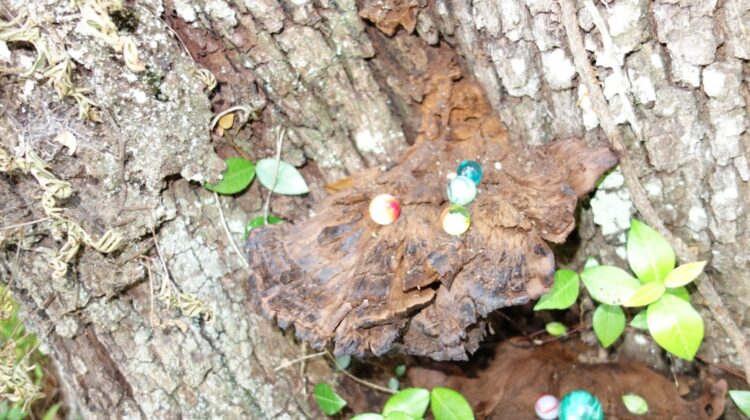
Ever been a bit deeper in the woods than you’ve gone before, or have you ever been camping off trail and, for no reason that you can think of, have you felt a bit spooked, and maybe a tad uneasy? Hair on your neck rises and, for some reason you can’t explain, you are breathing a bit shallow. We have. We felt that way while hiking and climbing in the Joyce Kilmer-Slick Rock Wilderness in North Carolina. And sometimes you just can’t pinpoint what’s making that odd sound; or you can’t determine the direction the sound came from. Or was that really a sound at all? Was it vocalization?
We have always been as comfortable at night in camp as in the daytime. But it is odd when you are all settled in and suddenly hear a high-pitched whistle. Or is that really a whistle at all? Not threatening; not at all loud, and not really scary, but somehow unsettling.
We have seen bear in the woods and in North Carolina accdently walked within feet of a wild cat eating her kill on the Davidson River. We know many, sometimes unnerving, sounds that wild animals can make: for example, have you ever heard a buck snort? An alligator bark? Bears can and do roam at night and they can make noises which can carry long distances in the quiet deep woods.
The barred owl has a distinct night call. But that night whistle sure sounded odd. You turn over and try to get more comfortable, but sleeping on the ground can be a bit uncomfortable at best. There it is again: no it is not a call at all. Could that whistle possibly be vocalization; some form of communication?
Se’sxac
We know that by now you realize that we are talking about the cryptid Sasquatch. A cryptid is a creature that is found in stories, legends, and folkways. It is a cultural phenomenon. Many people believe that Sasquatch is real and is flesh and blood. Others believe that it is real, but not physical at all. Perhaps better known in America as Bigfoot, we know that this cryptid is “…large, hairy, human-like…” and it is “…particularly associated with the Pacific Northwest of North America.”[1]
While the “animal” (if that is what it is) is known by an inexplicable number of names, we prefer the indigenous name Sasquatch. The word Sasquatch is derived from the Salishan word Se’sxac which is translated as “wild men.” The English name for the Salish peoples, who speak some twenty-three languages, is Flat Head. The Salishan languages are a family of languages of the Pacific Northwest to include Washington, Oregon, Idaho, Montana, and British Columbia in Canada.
“All Salishan languages are considered critically endangered, some extremely so, with only three or four speakers left. Those languages considered extinct are often referred to as ‘sleeping languages’, in that no speakers exist currently. In the early 21st century, few Salish languages have more than 2,000 speakers. Fluent, daily speakers of almost all Salishan languages are generally over sixty years of age; many languages have only speakers over eighty.”[2]
Folklore & The Stuff of Legends
The American Folklore Society[3] tells us that: “Folklore is our cultural DNA. It includes the traditional art, stories, knowledge, and practices of a people. While folklore can be bound up in memory and histories, folklore is also tied to vibrant living traditions and creative expression today. Folklore adapts, and folklore endures.”
This is why we prefer the name Sasquatch over Bigfoot. Stories of the creature abound in the rich cultural heritage of the Salish while the “fringe creature” is also known to the Apache, Paiute, Wasco-Wishram, and Yakama, to name only a few Native American cultures which have interwoven Sasquatch into their folkways and cultural legends. In fact the creature is often intertwined with the Native American creation myths.[4] Microsoft Copilot tells us that the Salish use of “Sasquatch” reflects their connection to the wild and mysterious aspects of nature. Se’sxac is a testament to the enduring power of language and folklore.
Where Bigfoot Walks[5]
Robert Michael Pyle tells us that “something is definitely afoot in the forests of the Pacific Northwest. Either an officially undescribed species of hominoid primate dwells there, or an act of self- and group deception of astonishing proportions is taking place. In any case the phenomenon of Bigfoot exists. Whether the animals themselves are becoming scarcer or whether they even walk as corporeal creatures at all, their reputation and cult are only growing. More and more people, including credible and skeptical citizens and scientists, as well as the gullible, the wishful, and the wacko, believe that giant hairy monsters are present in our midst….”
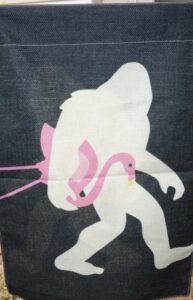 The Bigfoot Phenomenon
The Bigfoot Phenomenon
There can be no question about Bigfoot being a national phenomenon. There are dozens of places to visit Bigfoot all over America! Just use your favorite browser and type “Bigfoot exhibits USA”. Many, if not all, of these centers welcome children.
Admission costs about $10.00 for adults and about half that for children. Some of these exhibits and museums also offer research and the opportunity to go on a Bigfoot hunt. The cost and nature of hunts vary but a basic trip can be booked for about $125.00.
And some of the museums and exhibits offer Bigfoot shops where you can buy Bigfoot beach towels, writing pens, a catnip toy, mugs, an historic replica of a footprint cast, key chains, T-shirts, jigsaw puzzles, caps, socks, plush toys, books, mugs, boxer briefs, earrings, and Christmas ornaments, and even cotton candy called “Bigfoot poo.” This image is a photo of a Bigfoot garden flag. One thing strikes us as odd, however. We could find no Bigfoot marbles anywhere on line.
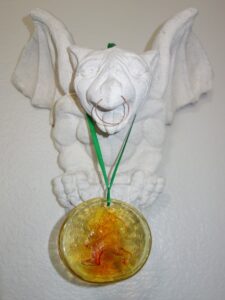 It isn’t only the Bigfoot museums and exhibits which have Bigfoot goodies. When we visited Blenko Glass Company in Milton, West Virginia, we bought what is now a prized possession. It is a four inch Bigfoot tangerine sun catcher. It cost $28.00 and we have found it online with other vendors listed for almost three times as much![6]
It isn’t only the Bigfoot museums and exhibits which have Bigfoot goodies. When we visited Blenko Glass Company in Milton, West Virginia, we bought what is now a prized possession. It is a four inch Bigfoot tangerine sun catcher. It cost $28.00 and we have found it online with other vendors listed for almost three times as much![6]
A Little Background For Strangeness
We won’t even attempt to track the Bigfoot mania in America to its roots. As you know Sasquatch is in the very creation myths of some indigenous peoples and there are literally thousands of pages online and in print. We want to keep our focus much more narrow.
However, since we do want to develop the concept of gifting Sasquatch, we will review how the modern American legends of Bigfoot may have started. “No one knows for sure when the Northwest’s Bigfoot legend truly began, but the most successful launching pad for the public’s obsession with it is known: a battle that supposedly took place in a narrow gorge on the east flank of Mt. St. Helens. The gorge is now called Ape Canyon.”[7]
You can get some remarkable information, a photograph, and a map, of the unforgiving terrain of “Ape Canyon”[8]. This website allows you to form some perspective on where the historical ape battle took place and what many people thought about the primate early on.
“Mountain Devils”
So, what about that battle with mountain devils? Well, it was a doozy! It happened in 1924 deep into the narrow gorge to the southeast of Mount St. Helens in Washington. Today the gorge is named Ape Canyon because of the battle. There are a number of modern accounts of the attack[9] but we found a news story from the time which is much more dramatic. Newspapers in both Washington and Oregon ran stories about the battle.
“’Savage Beasts Hunted’ Kelso [Southwestern Washington], July 1 [1924] Led by Forest Ranger C. Parker, an expedition started from here this morning into the heart of the Spirit lake country to search for the ‘mountain devils,’ a band of giant gorillas which have badly frightened prospectors who said that they had chased them from the woods after an intermittent three-day battle. With Parker are Frank Helm and R.S. Bailey. The men are armed for big game, and also carry photographic equipment. The prospectors, all veterans of this district, are Marion and Roy Smith, J. Paterson and Fred Beck.”
According to their story, they were attacked several times by weird beasts, succeeded in killing one and wounding several and finally fled from the woods themselves after they had been held prisoner an entire night by a cordon of 30 gorillas.[10] According to the men, their cabin was bombarded with heavy rocks throughout the night. More than 200 rocks crashed thru the roof to the floor of the shack, they asserted.”
Wow! You’ll never see anything like that on Finding Bigfoot! Just a couple of notes: We think that the Smiths were father and son. The prospectors, who had started to mine a lode, rode to their campsite in “Hank’s” Ford. Fred Beck, of Kelso, wrote or told the story of the battle.[11]
Beck’s Remembrance
Here is some flavor of Fred’s memories of that July night in 1924:
“The attack ended just before daylight. Just as soon as we were sure it was light enough to see, we came cautiously out of the cabin. It was not long before I saw one of the apelike creatures, standing about eighty yards away near the edge of Ape Canyon. I shot three times, and it toppled over the cliff, down into the gorge, some four hundred feet below.
Then Hank said that we should get out of there as soon as possible; and not bother to pack our supplies or equipment out; ‘After all,’ he said, ‘it’s better to lose them, than our lives.’ We were all only too glad to agree. We brought out only that which we could get in our packsacks. We left about two hundred dollars in supplies, powder, and drilling equipment behind.”
Bigfoot is Alive & He’s Mad & Mean!
Photo by Stacey Dunn
Many people in 1924 did not question the veracity of the miners’ claim. After all in today’s dollars they left $3,665.00 in grub stake in the cabin. They had found gold indicators and had it assayed. It was possible that there were one or more lodes in the area. No miner would leave that situation without further prospecting and mining. But they did.
Evidently no one today knows where the cabin was. This in itself is strange. A solidly built cabin with no windows should surely be standing in some form after one hundred years. And if it isn’t then there should be a feature remaining where it stood: Timbers; a footer outline; a can or jar or two. Did the miners, or anyone else, return for their grub stake?
But the big idea is this: Bigfoot was established one hundred years ago as a flesh and blood bi-pedal primate which could and did interact with humans. We can postulate from the story that Bigfoot, like many if not most primates, is spatially territorial and he does exhibit defense behavior. The message is “leave now.” We can also tell from the story that Bigfoot lives in a family group. We cannot tell whether or not the family would band together with other family groups. If there were 30 or more individuals involved as reported in some accounts in 1924, they must be a larger family than usual.
“Tarzan the Bigfoot”
We could go on. We have been thinking about why miners in the 1924 American Northwest would believe that they were under attack by a family or troop of gorillas. Gorillas are ground dwellers and plant eaters who live in the forests of Sub-Saharan Africa. Since the 1960s there are feral Gorillas in Southern Florida which have escaped from zoos or have been turned out by pet owners.[12] But we wonder if any or all of the miners had ever seen a live gorilla.
We want to mention something that we have never seen in print, social media, nor on television. The novel Tarzan of the Apes was published in 1912 and the first Tarzan movie, Tarzan of the Apes, was released in 1918. Elmo Lincoln starred in the movie as Tarzan. Now think about this: syndication of the novel began on July 2 1921 in The Seattle Star with coverage of Seattle and King County. The name of the Tarzan serial was “Tarzan the Terrible.” We don’t know how many other newspapers were running the Tarzan serial at the same time.
Metaphysics: Sasquatch & Bigfoot
Sasquatch is metaphysical and the entity has been supernatural for uncounted generations. Sasquatch is now and always has been understood as a spiritual being. Bigfoot, as non-natives view him (and her), has evolved over the past one hundred years from a physical flesh and blood creature into some sort of metaphysical inter-dimensional entity which still presents as some type bi-pedal primate. Of course, many researchers still insist that Bigfoot does, at least at times, have physicality. But others present evidence that the creature can apparently cloak itself, and it has been reported to be in two places at once! Some researchers claim that it can disappear.
There is taste of the supernatural in the Beck book. Fred Beck was one of the miners in the shack that July night in 1924. This is in Chapter Three, and you can read it online.[13] Beck writes:
“The events leading up to the ape episode were filled with the psychic element… I will say that ‘they are not entirely of the world.’ I know the reaction we experienced as these beings attacked our cabin impressed many with the concept of great ape-like men dwelling in the mountains. And I can say that we genuinely fought and were quite fearful, and we were glad to get out of the mountains but I was, for one, always conscious that we were dealing with supernatural beings, and I know the other members of the party felt the same.”
Coming Full Circle
This consciousness of the supernatural may help explain why the party did not return to the cabin. Beck had a tooth ache during the attack and directly after the party got down from the Canyon he had the tooth pulled. As he left the dentist someone took him to speak with a small party of Yakama. The Native Americans told him that …”the Indians knew about them [Selahtiks], but white men never believed the tales of Indians. They said they were very careful never to go where they knew them to be, and if they ever found themselves in their presence they were doubly careful not to offend them.”
We find it very interesting that non-Native thinking about Bigfoot has slowly evolved from the time of the first contacts with Native Americans until today. Our thinking went from the physical, which the Yakama and others never accepted as the whole phenomena, to the metaphysical, which the First Americans had always held true. Finally we have come to think about Bigfoot like Native Americans who have always believed about Sasquatch.
Quantum Weirdness
Photo by Stacey Dunn
In his book The Quantum Bigfoot: Bringing Science and Spirituality Together[14] Ronald 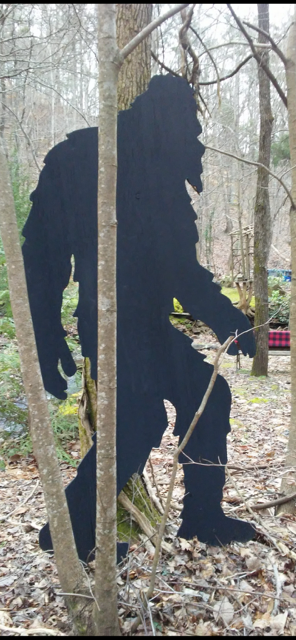 Morehead asks the question “so how does quantum physics relate to spirituality and Bigfoot? In my 45+ years of researching this phenomenon, I’ve heard several very strange reports. …. The accepted mathematics of quantum physics says that there is more going on than what we see with our three-dimensional eyes. Scientists now know, through physics, that empty space (Dark Matter, Dark Energy) is not actually empty…however, it is a dimension existing outside of the human light spectrum and the observable vibrational frequency.”
Morehead asks the question “so how does quantum physics relate to spirituality and Bigfoot? In my 45+ years of researching this phenomenon, I’ve heard several very strange reports. …. The accepted mathematics of quantum physics says that there is more going on than what we see with our three-dimensional eyes. Scientists now know, through physics, that empty space (Dark Matter, Dark Energy) is not actually empty…however, it is a dimension existing outside of the human light spectrum and the observable vibrational frequency.”
It seems to me that classical science has restricted itself by its own disciplines and because of those disciplines, will never grasp the big picture. If we use the classical box to try and determine all that exists, we would never begin to understand the cosmos, e.g., the world of spirituality. The math of quantum physics indicates that there are at least eleven dimensions in existence…possibly innumerable. So, could the laws of quantum physics be the answer to the Bigfoot mysteries?”
According to Microsoft Copilot vibrational frequency refers to the measure of energy in a system. Everything, including our bodies, and we can only propose Sasquatch bodies as well, is composed of energy. Different types of energy vibrate at varying rates. The average level at which your energy vibrates is your vibrational frequency.[15] Native Americans tried, and almost always failed, to tell pioneers, cowboys, and miners about Sasquatch’s vibrational frequency centuries ago. Bottom line: Bigfoot vibrates on a different frequency than humans.
If you want to get into the quantum theory as applied in the Bigfoot phenomena, which is very much in alignment with many Native American beliefs, then get Morehead’s book. And by the way, Ron is renowned for collecting the Sierra Sounds[16] which is a collection of Bigfoot vocalizations. And consider this. The whistles and “tree knocks” with which we are familiar may not be at all what we think they are. Both may be vocalization techniques used over a distance.
Gifting Sasquatch
By now we are certain that you know what’s next on the menu. Researchers today have moved the Sasquatch phenomena so far along the axis that it seems both natural and right that people looking for Sasquatch would leave small gifts or objects in the forest. The belief is that the entities will interact with you if you have a right state of mind when you offer a gift. The idea today is to stay non-confrontational.
There are reports of Sasquatch taking the gifts —like food, clothes and woolen blankets, shiny objects, candy, nuts, trinket, and, of course, marbles. Food of all kinds is a favorite gift! Sometimes he or she will take a gift and leave a gift—maybe a shiny rock, pine cone, and other goodies. You simply leave your gift out in the open among tree roots, stumps, and on the ground. You leave things along game trails, or near the water where you have reason to believe the primates frequent. If this is a drinking spot then there will be all sorts of animal tracks in the mud or sand.
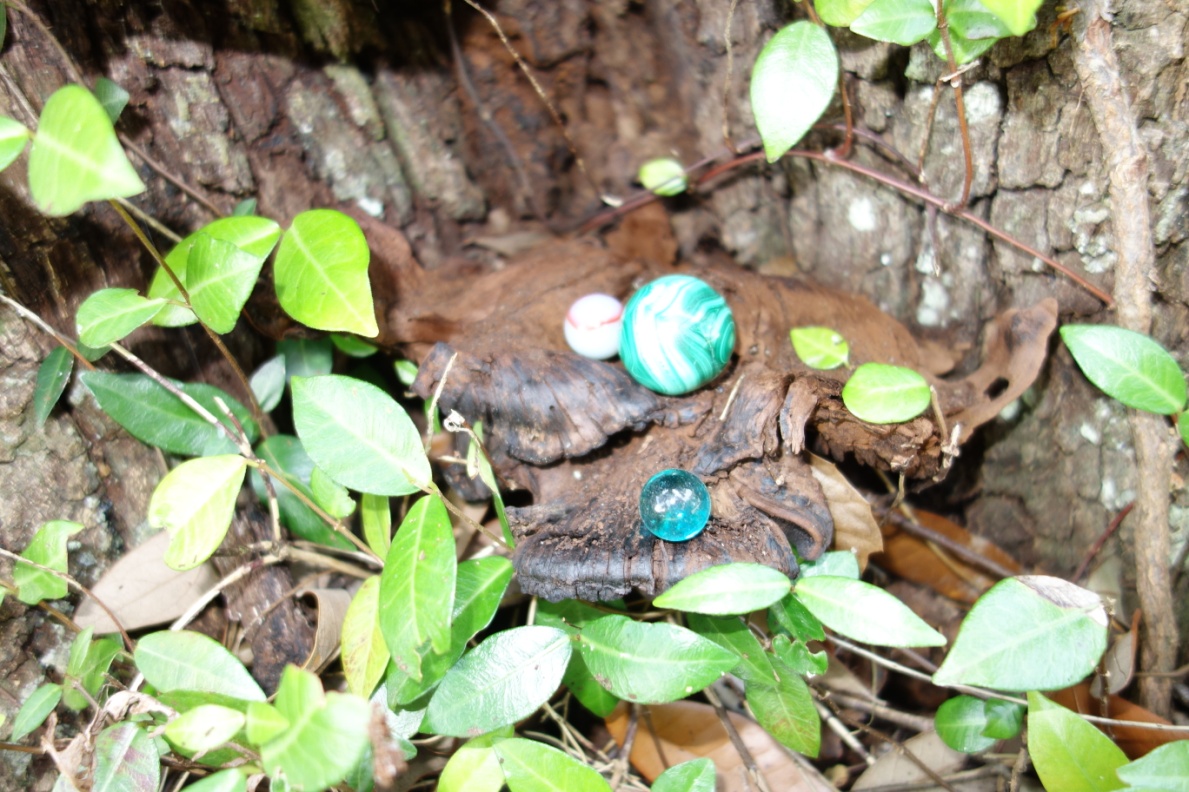
Enthusiasts believe that gifting can open lines of communication and reciprocity. Most claim that even if the gifts are not taken but only moved then the communication has been two-way. Of course, there is no empirical evidence that it is Sasquatch that you are communicating with. But the lack of such evidence is characteristic of where we are today in our search for Bigfoot.
Depending on which woods you are in, there is no telling what really took the gifts if you did not see her take it. We made an awful mistake once in camp. We love Vienna finger cookies and had managed to afford a whole bag! We ate a few at the fireside but failed to secure the rest. A gaze (look it up!) of raccoons, or maybe two or three gazes, relieved us of the whole pack and left the torn and empty bag about twenty yards away down the track! We know Sasquatch would have loved them, too, but the little raccoon tracks were unmistakable.
Honestly if you go into the woods to offer a gift to Sasquatch with an open mind and expecting nothing. After you leave the gift it really doesn’t matter what gets it! Physical animals love gifts and need food just like the metaphysical that they share the forest with.
Marble Gifts
If you have gifted Bigfoot then you may have already gained a lot of experience. Still, both experienced searchers and beginners might want to check “Harriett McFeely: How do you pick a gift for Bigfoot?”[17] This is what she has to say about gifting marbles: “Marbles are another Bigfoot favorite gift. Sometimes they take the whole gift, then return it as it was given to them after a period of time. Other times they rearrange the marbles into intricate designs for the finder to behold.” Again being spoilsports, we know that other animals do like shiny objects. Crows are not only highly intelligent but they also love anything shiny. Crows led Larry to a small cache of coins once.
This next story is from the Mike Quast book Sasquatch Central….
“Randy put out a question to the creatures –would they be more comfortable if he took his cameras down. When he did, activity at the peanut butter site seemed to increase a bit. He then got the idea to hang a bag of glass marbles in a tree at the site, and when he next came to check it, he found the bag broken open and the marbles scattered all over the ground. This seemed to be a sign of unease by the creatures, so Randy asked if they would give him a sign as to whether they were upset with him or if things between them were basically ok. The next time he checked the site, all the marbles were gone, and none have ever been found. Make of that what you will.”
Why Do Marbles Make Such Fine Sasquatch Gifts?
Microsoft Copilot explains that marbles themselves hold symbolism. They represent playfulness, childhood memories, and simplicity. There are no two exactly alike. We can only imagine what a Sasquatch must think when she picks up a marble for the first time. There is a whole world inside that tiny sphere and it shines in the sun like nothing else. A gift of marbles is a way for you to try and bridge the infinite gap between our physical world and the inter-dimensional world of Sasquatch.
Native American storytelling is all about magic, about life, travel, good food, family and a safe community. Well, a marble can be magic too. It really doesn’t matter whether or not it is a Sasquatch who takes the marbles. You have left a tiny gift or a number of tiny gifts for whatever mysteries there are in the dark woods. In this case it really is the thought of giving and the act of finding a spot and leaving the marbles behind.
Finally, we are delighted that marbles continue to be a part of legend, secrets, mystery, and lore. From time immemorial marbles have served as toys and they have helped frame a child’s childhood. They have also been used as weapons. Glass and stone marble manufacturing and the consequent sale of the marbles have been a critical factor in the life and economic health of many communities across the centuries.
And glass marbles have entered the folkways of peoples all across the world. They are the stuff of storytelling. Over time marble stories have been incorporated into the very fabric of Native and non-Native communities. And now we learn that marbles have been included as part of the legend and life of Sasquatch. Marbles do still have mystery and many secrets.
If You Want to Read Some More
Eastman, Charles A. (Ohiyesa) and Elaine Goodale Eastman. Wigwam Evenings 27 Sioux Folk Tales. Mineola, NY: Dover Publications, Inc., 2000. We could not find a Sasquatch story, but the book does convey the richness and expanse of the Sioux stories and lifeways. You might like “The Festival of the Little People” and “Eya the Devourer”.
Erdoes, Richard and Alfonso Ortiz. Stories selected and edited by. Native American Myths and Legends. NY: Pantheon Books, 1984. While we could not find a story specifically about Sasquatch (some Native Americans are hesitant to even say the name), but this book is a compendium of stories, especially creation stories, and it will give you an idea of just how rich and vibrant Native American stories and legends are. They help to bind together a folkway which has always been critical in guiding the people.
“Gifts From The Other Side” @ Bigfoot Gifting Stories – Sasquatch Gifts From The Other Side (sasquatchinvestigations.org) “This is probably the most important thing that happened that changed my mind long ago about what I was dealing with in the woods. These photos show what I have received from the Sasquatches over the years. This is not everything, but some of the most important things. They give of themselves what they have freely whether I leave food or not.” This story is about what the Sasquatches give to humans! It is a bit hard to follow because some text is written over the photos. Still, it is worth the time to sort it out.
“Go Find a Squatch.” @ https://sasquatchthelegend.com/ Go ahead, buy a Bigfoot “single rocker light switch cover!”
Green, John. Sasquatch: The Apes among Us. Blaine, WA: Hancock House Publishers, 2017th Edition (2006).
https://www.hancockhouse.com/collections/cryptozoology 6/6/2024
“Is Bigfoot real? A new book dives deep into the legend.” NPR @ Is Bigfoot real? A new book dives deep into the legend | KNKX Public Radio
Little, Becky. “Bigfoot was investigated by the FBI. Here’s what they found.” @ Bigfoot Was Investigated by the FBI. Here’s What They Found | HISTORY Updated June 26, 2023; Original June 6, 2019.
Marks, Michael. “What does Bigfoot sound like?” Texas Standard. October 31, 2023 @ What does Bigfoot sound like? Take a listen | KUT Radio, Austin’s NPR Station Recording 8:44 minutes.
Neuharth, Spencer. “What Does Bigfoot Eat?” September 2020. @ https://www.themeateater.com/conservation/anthropology/what-does-bigfoot-eat
Ostlind, Emilene. “John Mionczynski: A biologist revered and ridiculed.” September 20, 2011. @ https://wyofile.com/john-mionczynski/
“The 10 Best Bigfoot Books,” Bigfoot Times, Anaheim Hills, CA, Editor Publisher Daniel Perez. Email @ perez952@sbcglobal.net https://www.bigfoottimes.net/bigfoot-books/the-10-best-bigfoot-books/ 6/6/2024
“Tracking the Legend of Bigfoot.” @ https://statemuseum.arizona.edu/online-exhibit/curators-choice/tracking-legend-bigfoot
“Washington State Bigfoot History.” @ https://washingtonbigfoot.com/washington-state-bigfoot-history/ As you study the map “Ape Canyon Attack” you might want to ask yourself “Now how did the miners drive to their cabin where they were attacked?”
References
- You might want to check the online Cambridge English Dictionary @ https://dictionary.cambridge.org/us/dictionary/english/cryptid (5/31/2024) While Sasquatch is perhaps most often studied in the American Pacific Northwest, the phenomena are very real in Florida, the Ohio River Valley, and the Appalachian South. There are scattered reports from California. And of course, Yeti, Skookum, the Swamp Ape, and the Grass Man are known world-wide. There is an interesting online story “Looking for Bigfoot: New Map Shows Where to Search” which documents and maps Sasquatch American sightings 1921 – 2012 @ Looking for Bigfoot? New Map Shows Where to Search | Live Science 5/31/2024 ↑
- There is a remarkably informative and comprehensive analysis of the Salishan languages @ https://en.wikipedia.org/wiki/Salishan_languages 5/31/2024 ↑
- https://americanfolkloresociety.org/ 5/31/2024 ↑
- Check “Bigfoot in Native American folklore: A deeper look at the legend” @ https://fringecreatures.com/bigfoot-in-native-american-folklore-a-deeper-look-at-the-legend/ 5/31/2024
- Robert Michael Pyle. Where Bigfoot Walks Crossing the Wild Divide. Berkley, CA: Counterpoint, 2017. You can read at least portions of this book online @ https://www.google.com/books/edition/Where_Bigfoot_Walks/ 5/28 & 6/1/2024 ↑
- Evidently Bigfoot is alive and well in West Virginia. Sutton, for example, boasts the West Virginia Bigfoot Museum. See https://wvtourism.com/company/wv-bigfoot-museum/ 6/2/2024 ↑
- “How a 1924 Bigfoot battle on Mt. St. Helens helped launch a legend…” by Douglas Perry, The Oregonian/OregonLive, Published: Jan. 25, 2018. ↑
- https://www.google.com/search?client=firefox-b-1-d&q=ape+canyon#ip=1 (6/2/2024). There is also an Ape Cave and hiking trails to it. And, like Bigfoot himself, there are dozens of websites online which provide detailed information about the Canyon and the hikes into it. It seems incredible to us that prospectors would have ever built a cabin in the Canyon. ↑
- “The Ape Canyon Sasquatch Attack” By Eric Grundhauser @ https://www.slate.com/blogs/atlas_obscura/2015/06/16/washington_s_ape_canyon_got_its_name_from_an_encounter_with_extradimensional.html/ 6/2/2024↑
- Fred Beck later told his son that there were six gorillas involved: possibly a family troup. ↑
- Beck, Fred, as told to his son Ronald A. Beck. I Fought The Apemen of Mount St. Helens, WA. © Ronald A. Beck, 1967. ↑
- @ https://novum-terram.fandom.com/wiki/Gorillas_In_North_America 6/5/2024 ↑
- @ http://www.bigfootencounters.com/classics/beck.htm 6/4/2024 ↑
- Sierra Sounds, np. June 13, 2017. ↑
- How To Measure Your Vibrational Frequency – Hierarchy Of Consciousness (spiritualnexus.net) 6/5/2024 ↑
- Check it out @ https://audioboom.com/posts/8432808-the-sierra-sounds-the-voice-of-sasquatch 6/5/2024 ↑
- December 6, 2019 @ https://www.hastingstribune.com/harriett-mcfeely-how-do-you-pick-a-gift-for-bigfoot/article_598a4872-1871-11ea-8752-e7a8b834c707.html 6/5/2024 ↑

